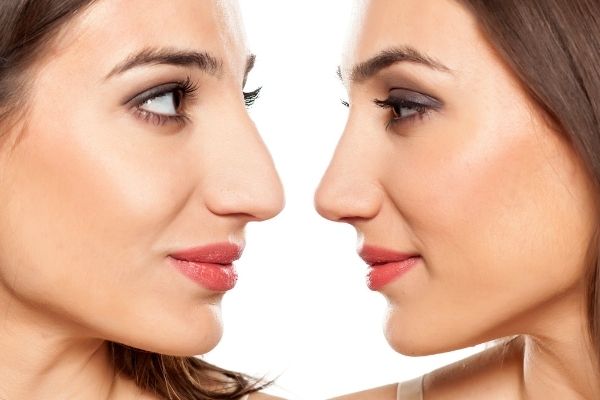Rhinoplasty also called a nose job, is done to alter the shape of the nose or reconstruct it to correct facial deformities. According to the American Society of Plastic Surgeons, nose reshaping is consistently one of the top five surgical procedures performed. With so many patients considering nose jobs, understanding the cost of surgery, and how it’s broken down is more important than ever. If you live in the Greater Los Angeles Area and are considering rhinoplasty, here’s what you need to know.
How Much Does Rhinoplasty Cost?
Rhinoplasty costs can vary depending on your surgeon, the area you live, and also the procedures to be performed. The American Society of Plastic Surgeons estimates that the average cost of a nose job is around $5,400. However, that figure is not the total price. Facility fees, anesthesia, and surgeon expense are just a few of the costs that are added to that amount.
So, what exactly are these fees? Well, here’s a quick breakdown.
- Facility fee — This cost might be the hardest to nail down. It encompasses a variety of expenses that can vary from practice to practice. It can include the medical devices used during the surgery, any materials or prescription medications, nursing care, and a general operating room fee.
- Anesthesia — Includes the fee for the anesthesia and is usually based on the type of surgery performed, how long it takes, and the type of anesthesia given.
- Surgeon’s fee — These fees also vary depending on experience and reputation. It’s essentially the cost the surgeon charges to keep her business running. Expenses incurred to keep the business up to snuff include rent, student loans, payroll, insurance, materials and supplies, etc.
Considering these additional fees, the price increases to anywhere from $7,500 — $10,000. And that’s just the base price. It can easily surge if there are additional complexities or extensive reconstructive work.
Reasons the Surgery Cost Will Increase
Besides the general facility and surgeon’s fees, there are other reasons rhinoplasty can cost more than average.
- Revision rhinoplasty — After a first nose job, a patient might be unhappy with the result or find that function isn’t normal. If that occurs, another surgery to correct the issue might be done. Revision surgeries are generally more expensive as there’s scar tissue already formed, a weakened structure, and potentially less cartilage to work with.
- Experience and notoriety — Whether performing an initial surgery or especially for a revision, experience matters. Rhinoplasty is an art form, and skilled surgeons have specific techniques in place to correct problems. Because of this experience and reputation, you’re going to pay more.
Ancillary procedures
Often when performing a rhinoplasty, there are additional procedures performed to improve the overall outcome and appearance. These procedures can cause patient satisfaction to increase dramatically. Here are some of the most common ones:
- Septoplasty — Septoplasty is the correction of defects of the septum. A septoplasty attempts to straighten the cartilage between the nasal openings. If the cartilage is crooked, it can be removed or sculpted for a more appealing effect. This is very helpful in fixing breathing problems. (This portion which is functional for breathing can be covered by insurance.)
- Turbinate reduction — Turbinates are small bones inside the nose that can block airflow. If your surgeon determines there’s a problem, they may reduce the size of turbinates in order to allow for improved airflow. (This porition which is functional for breathing can be covered by insurance.)
- Nasal valve repair – The nasal valves are the lateral walls of the nose along the nostrils and if they are collapsing, they can be repaired via various techniques by your surgeon to improve airflow as well. (This portion which is functional for breathing can be covered by insurance.)
- Sinus surgery – If there are issues with recurrent sinus infections or sinus headaches this can also be addressed at the time of your surgery. (This portion which is functional for sinus health can be covered by your insurance)
- Chin augmentation — The chin and nose go hand in hand when developing a pleasant facial aesthetic. To obtain that balanced look, chin augmentation might be considered by patient and doctor. (This is considered cosmetic and not covered by insurance like the rhinoplasty fees.)
While each of these procedures can increase the patient’s satisfaction with the end result, it’s going to cost additional money. These costs will be outlined and explained during the initial consultations with your surgeon.
What About Health Insurance?
Because it’s a surgery, you may be under the impression that health insurance will cover any costs. First and foremost, it’s important to check with your health insurance provider to see what kind of coverage you have. However, most insurance companies will not cover the costs associated with rhinoplasty (specifically cosmetic changes to the nose). That means if it’s considered cosmetic, it most likely won’t be covered.
However insurance can absorb some of the costs of your rhinoplasty if there is associated breathing or sinus problems as those portions are considered functional and your insurance may provide partial coverage for those portions, thus reducing the cosmetic costs some.
If you’re concerned with the cost of rhinoplasty, your surgeon’s office may work with you in developing a payment plan. Working together with the insurance company and the surgeon’s office can eliminate any surprises down the road.
Who Is a Good Candidate for Rhinoplasty?
Those with the following conditions may have good reason to consider surgery.
- Dorsal hump — A bump at the bridge of the nose
- Wide or narrow nose
- Asymmetrical nose
- Prominent nasal tip — A nasal tip that is disproportionate to the rest of the face.
- Airway problems — Breathing troubles or those with a deviated septum are good candidates for rhinoplasty.
While all surgeries come with risks, those with the following health problems are considered higher risk:
- Heart disease
- Elderly
- Overweight
- Smoker
Many surgeons are also on the alert for those that have body image issues and have difficulty accepting their appearance. Some patients have such extreme body dysmorphia that operating on them wouldn’t be an ethical decision. The bottom line is that if you’re healthy and have reasonable expectations about the surgery and aftermath, you’ll be a great candidate.
The Surgical Pro Treatment
Deciding to have rhinoplasty is a big decision. It requires picking a surgeon that is knowledgeable, confident and makes you feel comfortable. The team at C/V ENT Surgical Group, especially Dr. Hershcovitch and Dr. Cohen, are some of the top-rated surgeons in the Los Angeles area. They use cutting edge techniques to give you the best results possible. Dr. Hershcovitch is a facial plastic surgeon and has expertise in primary and revision rhinoplasty and fixing the cosmetic or outer appearance of the nose and has consistent and amazing results.
Dr. Cohen is a world-renowned nose and sinus specialist and has expertise in all of the breathing and sinus issues related to the functional and breathing parts of the nose. Dr. Cohen is the guy all plastic surgeons call on when patients end up with breathing problems after rhinoplasty. As such many patients end up with a combo approach with two experts addressing their functional and cosmetic issues respectively at the same time. They are consistently rated as the best Facial Plastic Surgeons and ENT specialists around and will do everything they can to make you feel better. If you’re thinking about rhinoplasty, don’t hesitate to set up a consultation with one of our doctors today.


